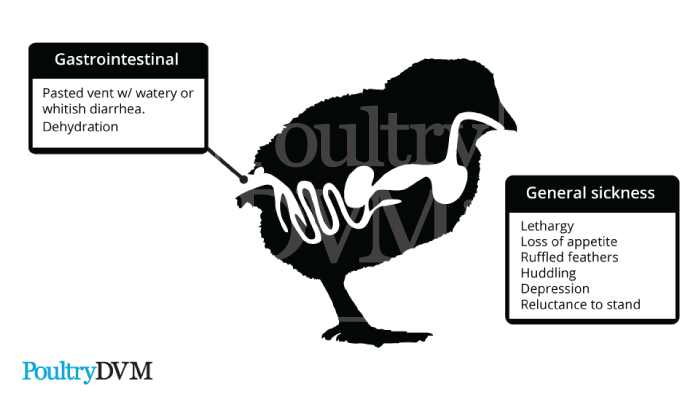Veterinary advice should be sought from your local veterinarian before applying any treatment or vaccine. Not sure who to use? Look up veterinarians who specialize in poultry using our directory listing. Find me a Vet
Other Names: Gumboro Disease, Infectious Avian Nephrosis

| Name | Summary | |
|---|---|---|
| Supportive care | Isolate the bird from the flock and place in a safe, comfortable, warm location (your own chicken "intensive care unit") with easy access to water and food. Limit stress. Call your veterinarian. | |
| Treatment of pasty butt | When poop hardens it can cause a blockage to the chick's gastrointestinal system, as if the poop has no way to leave the chick's body, the chick will die. Gather a warm wet facecloth, dry paper towels, and petroleum jelly (Vaseline). Using the facecloth, gently run it over the hardened poop. The intent is to clean it off completely, but depending on how hard it is this may take repeated attempts and a little time. Once clean, gently dry off the chick's bum with the dry paper towel and apply a small amount of petroleum jelly to the area that was sticky, to try to prevent fresh poop from sticking in the future. Repeatedly check on the chick, as this process is likely to need to be repeated. | |
| Thymulin 5cH | Diluted into drinking water | Sato C et al., 2012 |
| Calendula officinalis extract | 0.5 ml added to feed daily for for 7 days | S Marina et al; E Barbour et al |
| Ashwagandha (Withania somnifera) root powder | Added at 1% in feed ameliorates IBDV-induced hematological, biochemical, and immunological alterations, resulting in lower viral persistence in the host, and also afforded protection against virus-induced stress and histopathological changes. | Ganguly, Bhaskar, et al., 2019; Pant, M., T. Ambwani, and V. Umapathi.., 2012 |
| Baicalin (Scutellaria baicalensis) extract | 100-200 mg/kg of diet | Yan, Jing, et al. 2014; F Yang et al., 2020; Z Wu et al.,2020; Y Zhou et al., 2019; B Yin et al., 2021; M Bao et al., 2022; Z Hu et al., 2022 |

© 2024 PoultryDVM All Rights Reserved.